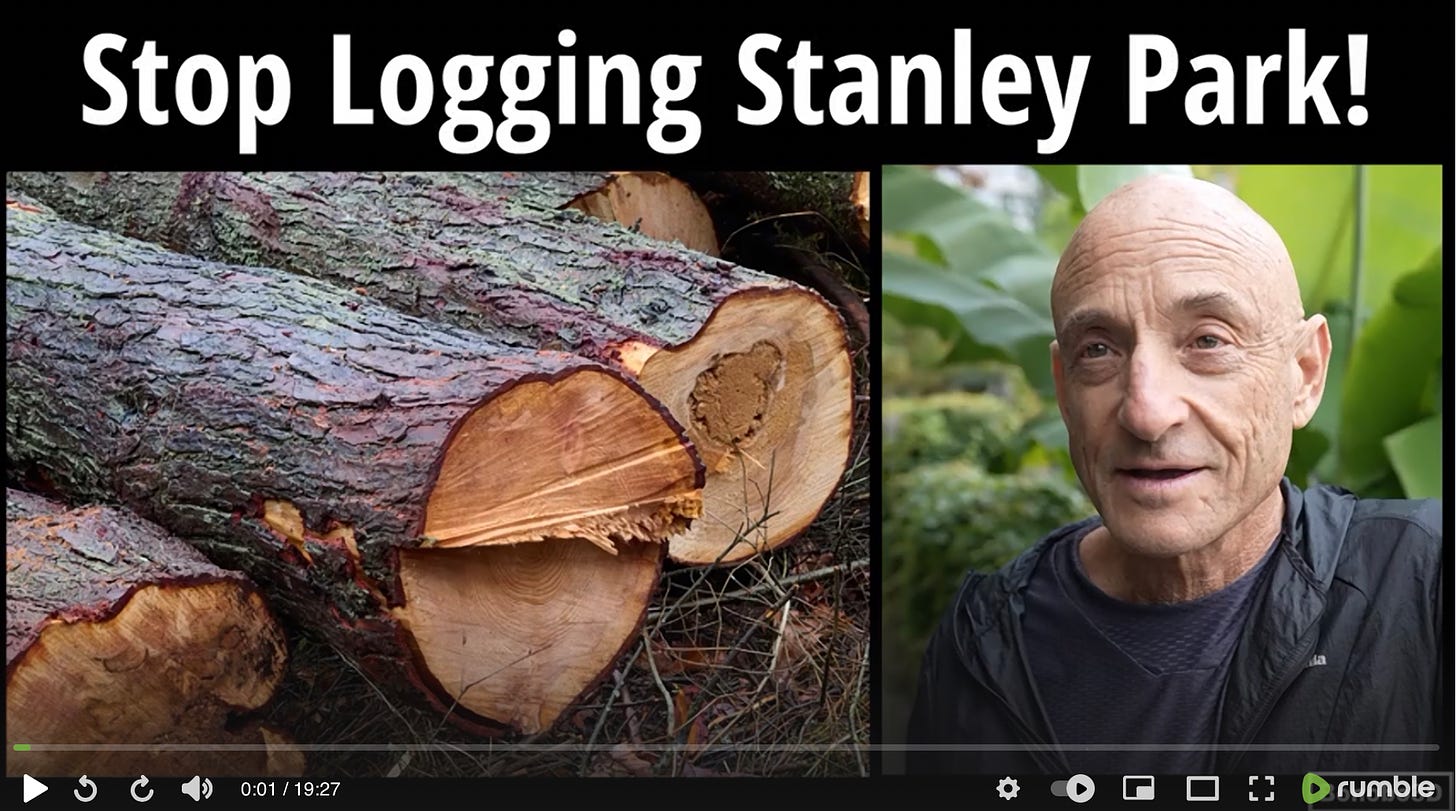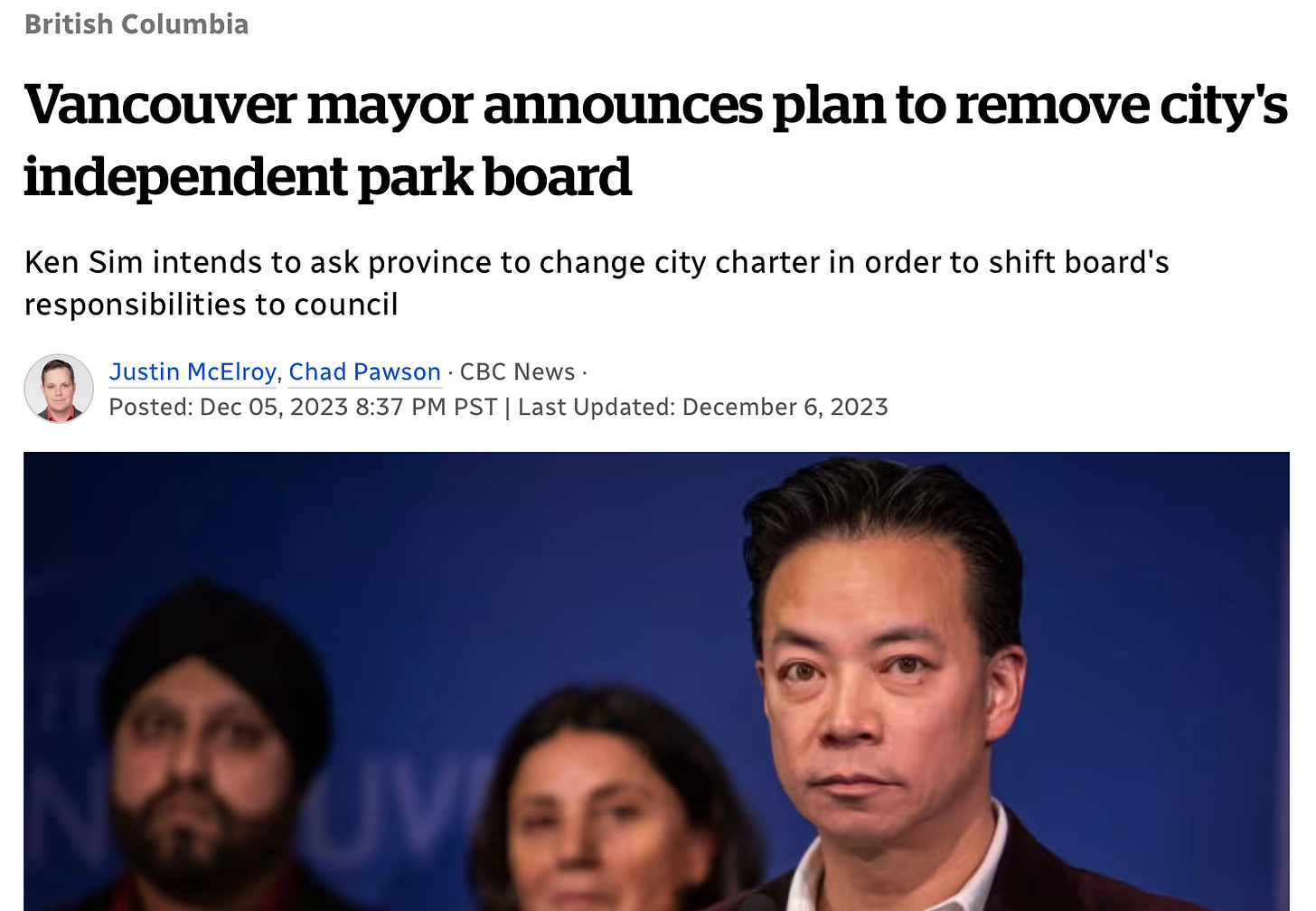Why Is Stanley Park Being Logged? Part 1
Four plaintiffs are suing the city and other defendants for negligence
Stanley Park is the crown jewel of urban green spaces on the west coast of Canada. The seawall, winding trails, wildlife habitat and old-growth forest make it an oasis for many residents and tourists. The closest urban example that comes to mind is New York City’s Central Park.
You’d think any official effort to visibly alter the park would be met with a huge pubic outcry. Especially if it involved cutting down trees.
Yet to date, crews have logged more than 7,200 trees, a small fraction of the projected 160,000 trees the City of Vancouver has targeted as part of the area treatment for a looper infestation. This would account for an astounding one-third of the trees in Stanley Park, making for a very visible alteration.
Is this radical surgery justified? Four members with Save Stanley Park insist it’s not. In an effort to stop continued logging, the plaintiffs are have launched a nuisance lawsuit against The City of Vancouver, the Vancouver Board of Parks and Recreation, and other parties. The City insists the logging is being done as sensible and necessary ecological treatment for the caterpillar’s impact.
Native to North America, the hemlock looper is considered a serious defoliator in Canada. It occurs from the Atlantic coast west to Alberta. It has destroyed several million hectares of conifer forests in eastern Canada over the years. The other subspecies, Lambdina fiscellaria lugubrosa (Hulst,) is found in British Columbia. The main hosts of this insect are balsam fir in eastern Canada and hemlock in western Canada. - Government of Canada
According to a report delivered to the Vancouver Board of Parks and Recreation in January by B. A Blackwell and associates, “Dead, looper-impacted trees are expected to decay and start failing (tops, branches, or whole trees) within the near-term and will continue over the next 20 years,” causing “unacceptable levels of risk to people and infrastructure.” The primary risks assessed are from wildfires and falling trees.
The plaintiffs insist the logging will actually increase the risk from both.
Plaintiff Michael Caditz explains the legal challenge here, and the affidavits from seven forestry and ecology professionals.
Eyebrow-raising elements
There are several eyebrow-raising elements to this story.
The first is that City Hall officials approved the first phase of the looper treatment behind closed doors last August, while city council and Parks Board staff were on summer holiday. The plaintiffs claim there was no motion made at a public Park Board meeting regarding this matter. The second eyebrow-raiser is the plaintiff’s claim there was no motion made at a public meeting to award an emergency-no bid contract to B. A. Blackwell and Associates to hire logging subcontractors for the park.
The seeming secrecy is the most concerning element to the Caditz. From the court filing:
“Plaintiffs find no evidence in the Park Board meeting summaries and minutes from January 2021 through July 2024 that a motion was presented or approved by resolution at a public (or any) meeting. Had such public hearing transpired, then experts with alternate recommendations and any conflicting scientific evidence would have had an opportunity to be heard.”
The third element concern the plaintiffs’ suggestion that Blackwell is in a conflict of interest position, as both the consultant in assessing the looper infestation and the general contractor for the mitigation work it recommended.
The fourth possibly related element is that ABC party leader and Vancouver mayor Ken Sim has announced his intention to abolish the Vancouver Parks Board, the body mandated to maintain and defend the integrity of the city’s many green spaces. The timing is intriguing. Such a move certainly would give the city an even freer hand in policy directives in the parks.
In their filing, the plaintiffs have included affadavits from seven forestry and ecology professionals to support their case. Among them is forest scientist Dominick DellaSala, who has a Ph.D. in Natural Resources from The University Michigan. In the CV attached to his affadivit, he states he has over 300 peer-reviewed publications and has coauthored 9 books “specializing in coastal temperate rainforests, wildfire ecology, wildlife management, climate change, and forest ecosystem assessments.”
On Aug. 5 he joined Caditz in touring the areas of Brockton Point, Prospect Point, and trails within Stanley Park to provide his expert opinion on the city’s approach to the looper infestation in the area.
“Based on my detailed observations, I strongly believe that further logging in the Park of up to 160,000 trees (1/3 of all trees) would cause irreparable harm to forest functions in recovery, increase fire risks, cause potential harm and injury from blow down in treated areas, and render the Park's ecosystems even more vulnerable to future disturbances,” he writes in his affadavit.
He goes on to describe the “increased potential from wildfires,” resulting from the “excessive removal of large, canopy trees leading to overly-ventilated forests where wind speeds are increased that will contribute to quickly spreading fires.” Other factors include the alteration by the treadments of “subsurface flow,” in effect making a wet event drier - and more at risk from fire.
But what of the city’s claim that trees killed by the looper represent a risk of falling, best addressed by thinning out the forest in these areas of the park?
His assessment:
“Elevated injury and property damage risks along trails and roadways are the result of removing the protective canopy that shields trees from blow down, the widely spaced trees in treated areas will function as "windsails" that catch the wind and are subject to breakage and/or dislodging of the roots. Notably, hemlocks, especially on wet soils, are shallow rooted species vulnerable to blow down when exposed by logging.”
Six other professionals have filed affadavits supporting the plaintiff against the city. Among them is Rhonda Millikin, a Registered Professional Biologist with a Ph. D. in Physics and Environmental Sciences, and an M.Sc. in Applied Ecology. She has 35 years experience in the Canadian federal government, including 10 years with Forestry Canada (now Natural Resources Canada) and 25 years with Environment and Climate Change Canada.
On August 25, she accompanied Caditz to assess the treatment areas of Stanley Park.
Echoing DellaSala, she argues that thinning trees to protect from fuel buildup in coastal rainforest stands of southwestern BC “increases solar radiation, wind speed and ambient air temperature, and decreases relative humidity and dead fuel moisture. These microclimate conditions resulting from fuel thinning increase fire susceptibility.”
The approach recommended by Blackwell and Associates in Whistler's coastal forests, “has increased forest fuel flammability, “ she insists.
And her response to the claim that trees killed by the looper infestation presents a public risk of falling?
“On 25 August, while touring the areas Fuel Thinned at Stanley Park by Blackwell and Associates, I observed that despite the objective of the RFP to protect humans from treefall due to looper damage, the trees with dead leaves due to looper attack remained standing and were significantly smaller in diameter than those trees removed by Blackwell and Associates.
Furthermore, the fire model used by Blackwell and Associates to justify Fuel Thinning, assumes there is no fire suppression capability. This is not true for Stanley Park where fire hydrants are regularly spaced throughout the park.”
Millikin holds that dead and dying trees are part of a functioning ecosystem “and essential for biodiversity, carbon sequestration, and nutrient availability for healthy trees.“
She concludes:
“No further disturbance to the Stanley Park forest should occur before a scientific panel is gathered of forest ecologists, and experts in ecosystem sustainability, soil health, integrated pest management, forest microclimate, and climate change adaptation, to prepare a document of options that will be presented to the public.”
DellaSala’s conclusion is similar:
“All of the logging impacts noted in my report are antithetical to the Park's management goals and the high use of the park by visitors seeking solitude and the aesthetic quality of an unlogged area. The Park's ecosystems would better be served by true stewardship that maintains the integrity and character of oldgrowth forest conditions even when disturbed by looper infestations.”
Given the above claims, shouldn’t there be further public involvement before a final decision is made to extend logging in Stanley Park? The apparent secrecy that prefaced the initial treatment of the looper infestation also begs an explanation.
The court’s decision on the matter is pending.







Bureaucratic malfeasance, secrecy, a contentious subject; why, this is a perfect Conspiracy Theory!
They can't possibly be ill intentioned, can they? They want to 'save' Stanley Park, after all. So it's all good and we can go back to watching TikTok or whatever...
Could it simply be for the purpose of a lucrative no bid contract, how much is Blackwell profiting off of this? Or could it possibly be that and they intend to extend the dense urban west end /coal harbor into the park for profit?